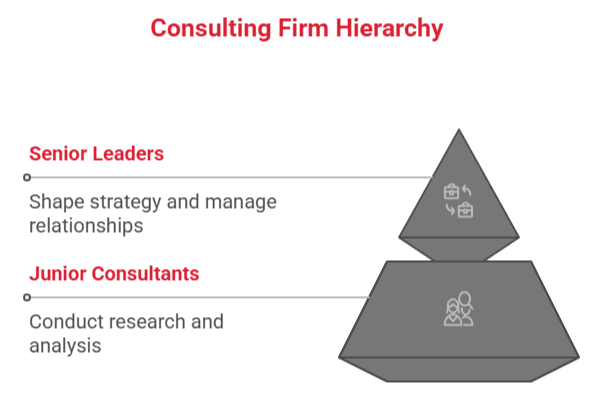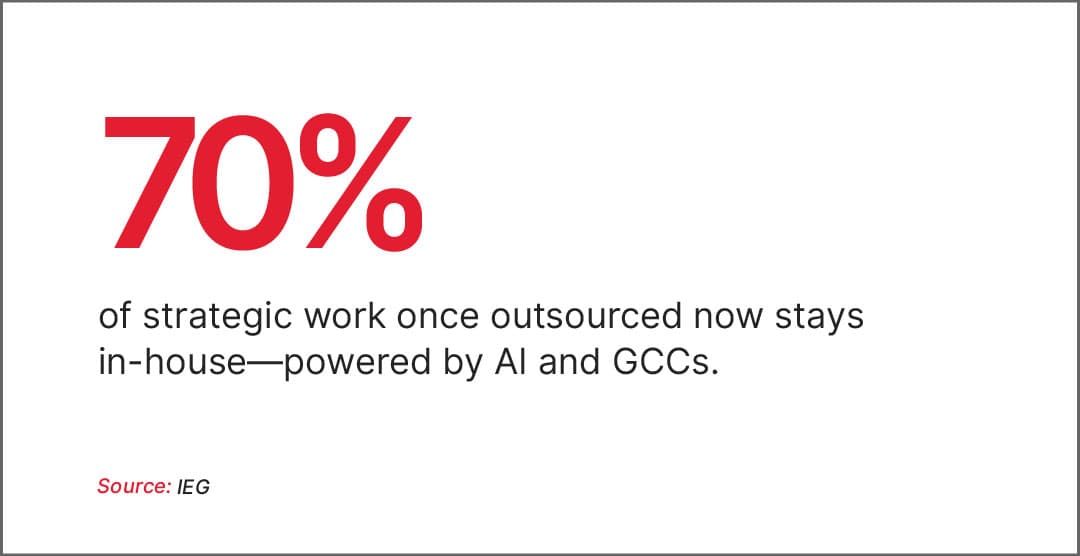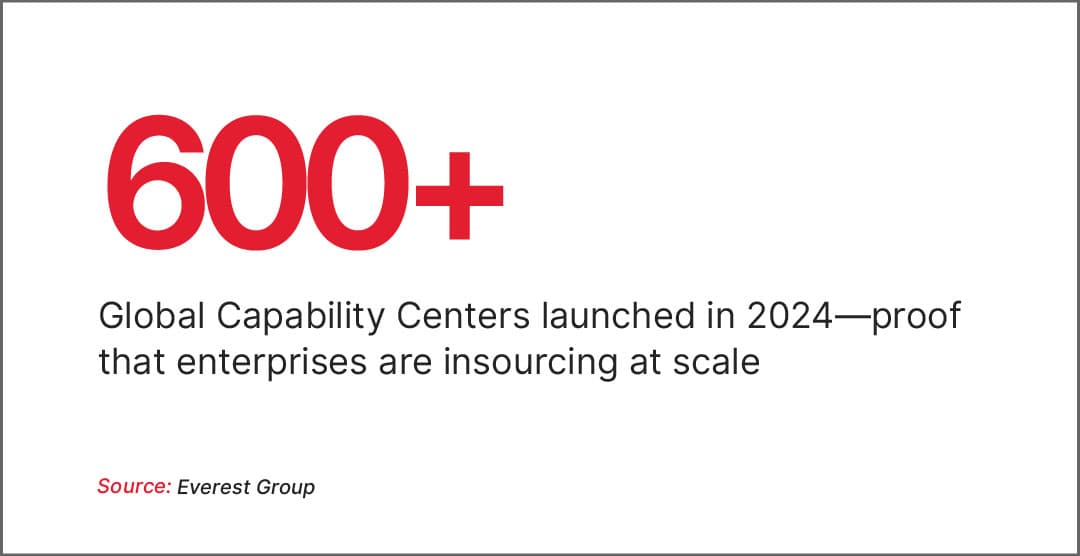Beyond the Pyramid: AI Innovation Sovereignty and the End of Consulting Dependence
2 October, 2025
Key Takeaways
- AI is disrupting the consulting premium by democratizing sophisticated analysis, shifting strategic capability from external advisors to internal enterprise teams.
- Global Capability Centers (GCCs) are emerging as enterprise-owned innovation engines, combining AI-native delivery, strategic talent management strategy, and data sovereignty to build compounding internal advantages.
- Consulting firms face structural paralysis. Their reliance on client dependency and the pyramid model prevents them from embracing disruptive enterprise AI strategy.
- Capability sovereignty is becoming the new competitive edge. Enterprises that insource expertise build institutional memory and proprietary insights consultants cannot replicate.
- The great insourcing has begun: future growth will favor enterprises that master internal capability building over those trapped in the fading architecture of advisory dependence.
Summary
AI is exposing the structural paradox at the heart of the consulting industry: the very pyramid model that built its success now prevents true innovation. Enterprises are shifting to insourced capability building, where internal teams, empowered by enterprise AI strategy, anchored in data sovereignty, and scaled through Global Capability Centers create compounding advantages that external dependency cannot replicate.
No longer cost-arbitrage units, GCCs have evolved into strategic hubs for talent management strategy and institutional learning, embedding sovereignty at the core of enterprise transformation. The consulting century yields to the age of intelligence, where enterprises reinvent themselves by owning the architecture of growth.
From the earliest trade guilds to modern corporations, enterprises have wrestled with a recurring dilemma: sustaining growth while adapting to technological disruption.
Harvard’s Clayton Christensen called it the innovator’s dilemma, the trap where market leaders become prisoners of their own success (Christensen, 1997). Success breeds blind spots, as profitable business models resist change.
Today, this paradox defines the bond between enterprises and their most trusted consulting advisors.
In boardrooms where enterprise strategy is forged, leaders still default to consulting firms when faced with enterprise transformation, rather than building global capability centers (GCCs) that compound internal expertise. The logic feels bulletproof: rent expertise, mitigate risk, outsource the hard thinking.
Yet beneath this architecture of authority, tectonic plates are shifting.
Enterprise AI is redistributing analytical power across the workforce, enabling AI-native internal capability development centers to generate insights once monopolized by external advisors.
" The question has shifted from ‘where to buy innovation’, to ‘where to build it’, and whether enterprises can achieve true innovation sovereignty before consulting dependencies become a dead end. "
Only 26% of companies have developed capabilities to generate tangible AI value (BCG, 2024), not because technology fails, but because their consulting ecosystem is trapped in its own innovator's dilemma.
Why Can't Incumbents Disrupt Themselves?
Consulting firms embody what Christensen described as sustaining innovators: adept at refining established solutions for large clients but structurally incapable of true disruption.
For decades, the industry has operated on a stable pyramid model. A wide base of junior consultants handling research and analysis, supporting a narrow apex of senior leaders who shape enterprise strategy and manage executive relationships.

The model essentially bundles two products:
- The tangible outputs (strategy frameworks, analysis) that they continuously improve through sustaining innovation
- The intangible core (legitimacy, risk mitigation) that boards rely on when making billion-dollar bets
This dual-product structure becomes a prison when AI democratizes the analytical capabilities that once justified their premium positioning. The evidence appears across the industry's flagship firms.
Read More: Elite Multiplication: How AI Is Reshaping Organizational Capability and Design
McKinsey's AI assistant Lili now serves 72% of its workforce, reducing research time by 30% (McKinsey, 2025). BCG deploys AI for presentation-building and a conversational agent (Forbes, 2024), while Deloitte's Zora agents automate foundational work (Deloitte, 2024). These tools erode the economic base of the pyramid by eliminating thousands of billable hours.
The paradox: incumbents cannot fully embrace disruption without dismantling the very structure that sustains their authority.
If the pyramid cannot survive AI democratization, the natural question becomes: where does that displaced capability go?
The answer is not back to the consulting firms, but inward, to enterprises themselves. This is the beginning of the capability in-sourcing revolution.
The Capability Insourcing Revolution: Evidence from AI Adoption
Evidence from the BCG Henderson Institute shows how AI collapses the consulting premium.
In controlled trials, 480 internal enterprise users using AI improved performance by up to 49% on data science tasks outside their expertise (BCG Henderson Institute, 2024). When AI enables internal capability building, enterprises reclaim innovation sovereignty.
The shift reframes talent strategy from outsourcing expertise to cultivating permanent skills and institutional memory.
A global financial services firm cut external spend by 35% while raising initiative success by 42% after establishing its own global capability center. Internal teams, equipped with AI, now handle 70% of strategic needs once outsourced (IEG, 2025).

The performance edge came from advantages external advisors cannot replicate:
- Internal teams already held organizational design knowledge
- AI tools democratized analysis once reserved for specialists
- Accumulated data sovereignty compounded across projects, where consultants take institutional knowledge with them when they leave.
The firm’s transformation further validates Christensen's theory that rather than competing at consulting premier’s tier, disruptive innovation wins through superior economics at routine tasks, not head-to-head competition with incumbent strengths.
The Incumbents' Innovation Paralysis
The consulting industry's resistance to change isn't mere stubbornness, it's structural inevitability.
Christensen’s innovator’s dilemma explains why incumbents cling to sustaining models, while resource dependence theory (Pfeffer and Salancik, 1978) reveals the trap beneath: firms rely on client comfort zones for revenue, making them incapable of advocating disruptive enterprise AI strategy that undermines their own economics.
This is why billion-dollar AI investments still get bolted onto obsolete pyramids. The same structures that once sold organizational design consulting now obstruct enterprise transformation.
Meanwhile, enterprises face sharper pressure points: protecting intellectual property, competing for scarce talent, and adapting to accelerated innovation cycles.
Increasingly, leaders recognize that outsourcing their talent strategy and innovation is untenable. True advantage lies in in sourced capability building and owning the architecture of their future.
" While AI democratizes analysis and capability building, consulting firms remain anchored to organizational design models that reward client dependency. They bolt AI onto existing pyramids rather than architecting talent strategy solutions. "
The Emergence of an Alternative Model
What once demanded entire cohorts of junior consultants is now executed at scale by AI, signaling a structural shift in how value gets created. While consulting firms wrestle with structural paralysis, enterprises are architecting entirely new organizational design models.
They are no longer renting expertise; rather investing in capability building internally through the global capability centers model.
Over 600 global capability centers were established in 2024 alone (Everest Group, 2025).

These GCC operating models combine AI-native delivery with strategic talent management strategy, allowing enterprises to control data sovereignty while building organizational design for innovation capabilities internally.
Learn more: How GCCs Are Evolving as Innovation Layers for Global Scaling
The GCC business model represents more than cost arbitrage. It embodies capability building as a competitive strategy.
When consulting contracts conclude , so does access to expertise; consultants leave, and institutional knowledge walks out with them.
Capability centers endure. They preserve insights, accumulate proprietary learning, and compound competitive advantages that cannot be rented from external advisors.
Breaking the Reliance Cycle with Global Capability Centers
Enterprises are waking up to a structural truth: consulting firms cannot dismantle the very models that sustain them.
The democratization of AI has become a catalyst. It places advanced capabilities and sophisticated analysis directly in the hands of the internal non-technical users.
This has led enterprises to break the consultancy reliance by building global capability centers (GCCs); insourcing innovation, securing capability sovereignty, and aligning with long-term enterprise AI strategy.
The winners will be those that master internal capability building, compounding advantage over time. The great insourcing has begun, and with it, the architecture of enterprise growth is being rewritten.
Bibliography
- Christensen, Clayton M. The Innovator's Dilemma: When New Technologies Cause Great Firms to Fail. Boston: Harvard Business School Press, 1997. https://www.hbs.edu/faculty/Pages/item.aspx?num=46.
- BCG. "AI Adoption in 2024: 74% of Companies Struggle to Achieve and Scale Value." BCG, October 24, 2024. https://www.bcg.com/press/24october2024-ai-adoption-in-2024-74-of-companies-struggle-to-achieve-and-scale-value.
- BCG. "How Gen AI Increases Productivity and Expands Human Capabilities." BCG Publications, 2024. https://www.bcg.com/publications/2024/gen-ai-increases-productivity-and-expands-capabilities.
- Deloitte. "Zora: Generative AI Agent." Deloitte US Consulting Services, 2024. https://www.deloitte.com/us/en/services/consulting/services/zora-generative-ai-agent.html.
- Everest Group. "Getting The Setup Right: The Early Aha Moments That Can Define GCC Success." Everest Group Blog, March 2025. https://www.everestgrp.com/blog/getting-the-setup-right-the-early-aha-moments-that-can-define-gcc-success-blog.html.
- Forbes. Smith, Craig. "BCG's Chatbot Gene Using Wider Context Windows and Faster Inference." Forbes, September 27, 2024. https://www.forbes.com/sites/craigsmith/2024/09/27/bcgs-chatbot-gene-using-wider-context-windows-and-faster-inference/.
- Institute of Enduring Growth. "Business Growth Consulting: Building Internal Capabilities vs. External Partnerships." IOEG Review, 2024. https://ioeg.org/review/article4.html.
- McKinsey & Company. "Rewiring the Way McKinsey Works with Lilli." McKinsey Digital, 2024. https://www.mckinsey.com/capabilities/mckinsey-digital/how-we-help-clients/rewiring-the-way-mckinsey-works-with-lilli.
- Pfeffer, Jeffrey, and Gerald R. Salancik. The External Control of Organizations: A Resource Dependence Perspective. New York: Harper & Row, 1978. https://www.jstor.org/stable/2778955.
FAQs
Q. Why are global capability centers critical for long-term resilience?
Global capability centers (GCCs) serve as innovation shock absorbers. When disruption hits, enterprises with GCCs can reconfigure talent, processes, and AI-native tools internally, without dependency delays.
Unlike external advisors, GCCs preserve institutional knowledge, allowing enterprises to pivot strategy while retaining accumulated expertise and sovereignty.
Q. What role do AI-native internal capability development centers play in talent strategy?
AI-native internal capability development centers shift talent management strategy from hiring for static skills to cultivating adaptive, AI-augmented teams.
They blend human judgment with algorithmic intelligence, creating a workforce that learns, scales, and compounds capability internally, something external consultants cannot embed into enterprise DNA.
Q. How does data sovereignty intersect with capability building?
Data sovereignty ensures that sensitive information remains within enterprise boundaries, strengthening both compliance and competitive edge.
When combined with insourced capability building, it prevents knowledge leakage to external firms. This intersection guarantees that analytical power compounds over time, transforming raw data into a strategic enterprise asset.
Q. If consulting doesn’t end, how is it being reinvented in the age of intelligence?
Consulting evolves from monopolizing analysis to complementing enterprise AI strategy. Instead of delivering bundled pyramids, firms will compete by offering niche expertise or partnering with AI-native global capability centers.
Enterprises are shifting the baseline; retaining control in-house via GCCs while selectively sourcing external insight where it adds unique value.
.jpg&w=256&q=75)
Zobaria Asma
Asst. Manager Brand & Communications
Zobaria serves as the Asst. Manager Brand & Communications at CodeNinja, driving brand strategy and communication efforts across diverse global markets, including APAC, LATAM, and MENA. With over 5 years of experience in scaling businesses, she brings expertise in SaaS branding and positioning. Her expertise spans a range of sectors, ensuring that CodeNinja's messaging resonates with diverse audiences while reinforcing its leadership in hybrid intelligence, AI-driven innovation, and digital transformation.
